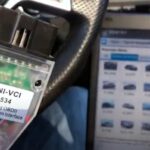OBD2 (On-Board Diagnostics II) plays a vital role in California’s Smog Check program. This system monitors your vehicle’s emissions system and helps ensure it’s running cleanly. This article explains how OBD2 impacts your smog check, what to do if your check engine light comes on, and answers frequently asked questions about OBD2 in California.
How OBD2 Affects Your California Smog Check
In California, a Smog Check inspection includes a visual and functional OBD2 check. Technicians verify the check engine light’s functionality and use equipment to communicate with your car’s computer, retrieving fault information. A current fault triggers the check engine light and requires repair before you can pass.
Your vehicle also stores “readiness indicators” showing if it’s ready for inspection. Too many “incomplete” indicators mean your car hasn’t run enough since the last memory clear to complete all system checks. This often happens after recent repairs or battery issues, not necessarily indicating a problem. Driving normally for about a week usually resolves this. If not, a technician can advise on specific driving patterns or use a dynamometer to set the monitors. They can pinpoint incomplete monitors using a scan tool.
For 2000 and newer vehicles, the Smog Check primarily relies on the OBD2 system; tailpipe tests are no longer required. Vehicles from 1996-1999 undergo both OBD2 and tailpipe tests. Some medium-duty vehicles (8,500-14,000 lbs GVWR) from 2000-2007 with federal-only certified OBD systems might require both.
Understanding OBD2 and the Check Engine Light
OBD2 monitors various components impacting emissions. If a problem is detected, the “Check Engine” or “Service Engine Soon” light illuminates, alerting you to a potential issue. The system stores details about the malfunction, aiding technicians in diagnosis and repair.
While a lit check engine light often signals an emissions problem, it can also affect fuel economy, performance, and driveability. A blinking light indicates a potentially damaging issue, often related to the catalytic converter, requiring immediate attention.
Common OBD2 Smog Check Questions
Q: Do I need to go to the dealer for repairs?
A: No. Properly equipped independent shops can diagnose and repair OBD2 issues. However, manufacturer warranties (generally 3 years/50,000 miles) often require dealer service. Certain components might have extended coverage (7 years/70,000 miles). PZEV (Partial Zero Emission Vehicle) and TZEV (Transitional Zero Emission Vehicle) certifications offer longer warranties (15 years/150,000 miles for emissions-related problems, 10 years for the hybrid battery).
Q: Can I use aftermarket parts?
A: Yes, as long as they are functionally equivalent to OEM parts. Aftermarket performance parts need CARB (California Air Resources Board) exemption, ensuring OBD2 compatibility. Check CARB’s database for approved parts.
Q: Can I use any catalytic converter replacement?
A: No. California requires specific performance levels for catalytic converters. Use dealer-provided or CARB-approved replacements. Check CARB’s database for approved aftermarket catalytic converters.
What if My Check Engine Light Comes On?
Prompt service is recommended. The severity varies, but ignoring the issue can worsen fuel economy, performance, or cause further damage. A blinking light necessitates immediate attention to prevent potential catalytic converter damage.
Conclusion
Understanding OBD2 and its role in California’s Smog Check program is crucial for vehicle owners. Addressing check engine light issues promptly, using approved parts, and staying informed about regulations will help ensure your vehicle passes its Smog Check and contributes to cleaner air in California. For further information, consult the CARB On-Board Diagnostic Program website.
